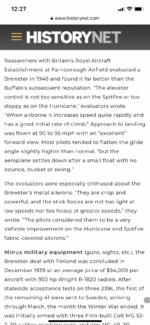Skyediamonds
Staff Sergeant
- 1,263
- May 26, 2018
Good afternoon everyone. I just read in HistoryNet that the Brewster Buffalo was one of the first fighters that featured sheet metal ailerons as opposed to the fabric covered ones of the Spitfire & Hurricane. It went on further to say that the Finns were greatly impressed with its "…crisp rolls in which the ailerons were not as sloppy as on the Hurricane. Light on elevator controls & not as sensitive as opposed to the Spitfire…."
I'd like to know how sheet metal covered ailerons & elevators would yield better responses on flight controls, if all other factors (airspeed, altitude, size & airfoil shapes, etc) bring equal.
I'd like to know how sheet metal covered ailerons & elevators would yield better responses on flight controls, if all other factors (airspeed, altitude, size & airfoil shapes, etc) bring equal.
Attachments
Last edited:

